The Cardinals of the Holy Roman Church (original) (raw)
The Cardinals of the Holy Roman Church Biographical Dictionary John XXIII (1958-1963) Consistory of March 19, 1962 (V)
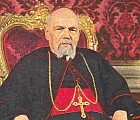
(43) 1. NUNES, José da Costa
(1880-1976)
Birth. March 15, 1880, Candelária, island of Pico, diocese of Angra, Azores, Portugal. Son of José da Costa Nunes and Francisca Felizarda de Castro Nunes. He was the third of nine children. The first, Cândido, died in infancy; he was followed by Ana Felizarda; José, the future cardinal; João; Manuel; Cândido; Francisco; Isabel Felizarda and Francisca Felizarda. The males eventually emigrated to the United States while from the girls, only one got married. He was baptized four days after his birth in the parish church of Candelária. His last name is also listed under Da Costa Nunes; and under Costa Nunes.
Education. Studied at the Seminary of Angra.
Priesthood. Went to Macau as missionary, June 4, 1903. Ordained, July 26, 1903, chapel of the episcopal palace of Macau, by João Paulino de Azevedo e Castro, bishop of Macau; celebrated his first mass the following 31 of July, in the church of Santo Agostinho, Macau. Pastoral ministry and faculty member of the Seminary of Macau, 1903-1906. Vicar general of the diocese of Macau and Timor, 1906-1913. Founder of the journal Oriente. Missionary work in Timor, 1913-1920. Vicar capitular of Macau, February 21, 1917.
Episcopate. Elected bishop of Macau, December 16, 1920. Consecrated, November 20, 1921, parish church of Horta, by Emmanuel da Costa, bishop of Angra, assisted by Manuel Augusto Xavier, dean of Horta, and by Francisco Nunes da Rocha, dean of Madalena do Pico. His episcopal motto was Duc in altum. Promoted to the metropolitan see of Goa and Damão, with title of patriarch of Oriental Indies, December 11, 1940. President of the Permanent Committee of International Eucharistic Congresses, July 13, 1953. Transferred to the titular see of Odessa with title of patriarch ad personam, December 16, 1953. Vice-camerlengo of the Holy Roman Church, December 16, 1953.
Cardinalate. Created cardinal priest in the consistory of March 19, 1962; received the red hat and the title of S. Prisca, March 22, 1962. Attended the Second Vatican Council, 1962-1965. Participated in the conclave of 1963, which elected Pope Paul VI. Papal legate to the 4th centennial celebration of arrival of the first Catholic missionaries to Macau, November 10, 1965. Lost the right to participate in the conclave by being older than eighty years, January 1, 1971.
Death. November 29, 1976, at 15.12 pm., in Clinica Madonna di Fatima, Via Bonincontri 9, Rome, assisted by his personal physician of twenty years, Professor Pasquale Tallarico. His body was exposed in the chapel of the clinic. The funeral Mass was celebrated at the patriarchal Vatican basilica on December 2 at 4 p.m. Buried, temporarily, in Campo Verano cemetery, Rome; his remains were transferred to the church of S. Antonio dei Portoghesi, Rome (1) (2). On June 27, 1997, his remains were solemnly transferred to the parish church of Candelária in Azores, Concelho da Madalena, where he was baptized. At his death, he was the oldest member of the Sacred College of Cardinals.
Webgraphy. Biography and testament, in Portuguese, diocese de Angra; photograph and biography, in English, Wikipedia; photograph and biography, in Italian, Wikipedia; photographs and biography by Eman Bonnici, in English, Find a Grave; brief biographical entry in Os Cardeais Portugueses, in Portuguese, patriarcado de Lisboa; his arms, Araldica Vaticana; D. José da Costa Nunes: A patriarch who cared for more than souls; A case of Cesaro-Papism in Portuguese India, 1942-1953 by Teotónio R. de Sousa, Paper presented to a conference on «Mission und Macht im Wander politischer Orientierungen. Europaeische Missionsgesellschaftgen und ihre Taetigkeiten in Afrika und Asien zwischen 1800 und 1945 in politischen Spannungsfeldern³, organized by the Berlin Missionary Society in March 2003, p. 243-256; 45 anni fa la morte del Cardinale portoghese Da Costa Nunes by Marco Mancini, ACI Stampa, Città del Vaticano, 29 novembre, 2021 / 9:00 AM.
(1) In his will he asked to be buried in that church if he died in Rome; and if he died in Portugal, in the cemetery of Horta, next to his parents.
(2) This is the text of the funeral monument in the church of Sant’Antonio dei Portoghesi:
CARDEAL DOM JOSÉ DA COSTA NUNES 1880 - 1976
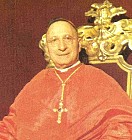
(44) 2. PANICO, Giovanni
(1895-1962)
Birth. April 12, 1895, Tricase, diocese of Ugento, Italy. Of a family of farmers. Sixth of the eleven children of Carmine Panico and Marina Zocco. His baptismal name was Santo Giovanni.
Education. Received the elementary education in his native city; first three years of studies ginnasiali with a private tutor; Seminary of Ugento, Ugento; Collegio Leonino, Rome, 1910-1915; Pontifical Roman Seminary, Rome, 1915-1919; Pontifical Lateran University, Rome, 1919-1922 (doctorate in theology, 1919; doctorate in both canon and civil law, July 1922). He was a keen musician who excelled as an organ and piano player; during his seminary years, he served as the official organist.
Priesthood. Ordained, March 14, 1919, patriarchal Lateran basilica, Rome, by Cardinal Basilio Pompilj, vicar of Rome. Further studies in Rome, 1919-1922. Shortly after his ordination, he founded two "Scholae Cantorum", for young boys and girls. Pastoral ministry in Tricase, 1922-1923. Cardinal Pietro Gasparri, secretary of State, invited him to be attaché of the nunciature in Colombia, February 1923-1926. Privy chamberlain of His Holiness, August 25, 1923. Auditor of the nunciature in Argentina, and accredited also in Paraguay and Uruguay, 1926-1931; in Czechoslovakia, 1931-1932; chargé d'affaires in Bavaria, 1932-1933; in Czechoslovakia, 1933-1935; observer of the Holy See in the plebiscite in Sarre, August 1934-January 1935; returned to Prague in 1935 and contributed to the foundation of the University of Bratislava. Domestic prelate of His Holiness, August 20, 1934. Decorated with the Legion d'honnore of France.
Episcopate. Elected titular archbishop of Giustiniana Prima and appointed apostolic delegate in Australasia (Australia, New Zealand, Polynesia and Dutch Indies), with residence in Sydney, October 17, 1935. Consecrated, December 8, 1935, chapel of the S.C. of Propaganda Fide, Rome, by Cardinal Pietro Fumasoni Biondi, prefect of S.C. for the Propagation of the Faith, assisted by Bartolomeo Cattaneo, titular archbishop of Palmira, general treasurer of the Apostolic Chamber, and by Domenico Spolverini, titular archbishop of Larissa di Tessalia, consultor of the S.C. Consistorial. His episcopal motto was Respice stellam. Papal legate to the 4th Plenary Council of Australia and New Zealand, Sydney, April 25, 1937. Papal legate to the Eucharistic Congress, Wellington, New Zealand, November 20, 1939. Visited Indonesia and presided over the Eucharistic Congress of Java. During the Second World War he realized an extraordinary charitable activity in favor of the Italian, German and Japanese war prisoners in Australia as well as the Australian and New Zealander war prisoners in Italy; he established the "War Prisoners Bureau" in the apostolic delegation in Sydney. Nuncio in Perú, September 28, 1948. Apostolic delegate to Canada, November 14, 1953. Nuncio to Portugal, January 25, 1959.
Cardinalate. Created cardinal priest, March 19, 1962; received red hat and title of S. Teresa al Corso d'Italia, May 24, 1962. Founded the Hospital Cardinale Giovanni Panico in Tricase.
Death. July 7, 1962, of a frail health for years after suffering two attacks, he died at noon in Tricase. The solemn funeral Mass was celebrated by Gaetano Pollio, P.I.M.E., archbishop of Otranto, on July 11, 1962, in the mother church of Tricase; twelve archbishops and bishops were present. Buried in the tomb of his family in the small cemetery of Tricase. His remains were transferred from the cemetery on the following December 17, and reinterred, according to his wishes, in the crypt of the church della Nativitá e della Beata Maria Vergine, in that city, where he had served as an altar boy as a child. On June 23, 2012, his remains were placed in an enclosure in front of the altar of S. Carlo Borromeo in that same church (1>
Bibliography. "Cardinali defunti." Annuario pontificio per l'anno 1963, Città del Vaticano : Tipografia poliglotta vaticana, 1963, p. 88*; "Il Cardinale Giovanni Panico". L'Osservatore Romano [electronic resource]. Città del Vaticano : L'Osservatore Romano, CII, n. 65 (March 20-21, 1962), p. 5; Fracasso, Rodolfo; Ricchiuto, Gerardo. Il cardinale Panico e la sua terra. A cura di Donato Valli. Galatina (Lecce): Congedo, 1995; "I funerali di Cardinale Panico." L'Osservatore Romano [electronic resource]. Città del Vaticano : L'Osservatore Romano, CII, n. 157 (July 12, 1962), p. 2; LeBlanc, Jean. Dictionnaire biographique des évêques catholiques du Canada. Les diocèses catholiques canadiens des Églises latine et orientales et leurs évêques; repères chronologiques et biographiques, 1658-2002. Ottawa : Wilson & Lafleur, 2002. (Gratianus. Série instruments de recherche), pp. 262-263.
Webgraphy. Biographical entry, in German; chronogram, in English, Catholic Hierarchy; photograph and biographical entry, in Italian, sixth on the page; his arms and photographs, Araldica Vaticana; Piazza "Cardinale G. Panico", comune di Tricase.
(1) The inscriptions on both vaults, kindly provided by Mr. Eman Bonnici, from Malta, read:
GIOVANNI PANICO CARDINALE DI SANTA ROMANA CHIESA * 12-IV-1895 † 7-VII-1962
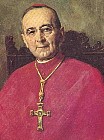
(45) 3. ANTONIUTTI, Ildebrando
(1898-1974)
Birth. August 3, 1898, Nimis, archdiocese of Udine, Italy. Sixth of the seven children of Giuseppe Antoniutti and Anna Comelli.
Education. Initial studies in Nimis; then, studied at the Seminary of Cividale, Friuli (classics); at the Seminary of Udine (theology); at the Pontifical Roman Seminary, Rome (theology); and at the Pontifical Lateran University, Rome, where he obtained doctorates in philosophy, theology and canon law in July 1920.
Early life. During the years 1915 to 1918 of the First World War, he accompanied the archbishop of Udine in his frequent visits to military hospitals and to parishes in the occupied zones. In 1917, the day after the Battle of Caporetto, he followed the archbishop in the vicissitudes caused by the advance of the Austro-Hungarian troops. At the beginning of November 1917, he went to Rome and continued his theological studies while in his free time assisting the seminarians from Friuli who had escaped the war.
Priesthood. Ordained, December 5, 1920, Udine, by Antonio Anastasio Rossi, archbishop of Udine. Celebrated his first Mass on December 8, 1920 in the altar of the Madonna Constantinopolitana in the basilica of S. Giustina, Padua. Faculty member, Seminary of Udine, 1921-1927. Secretary to the archbishop of Udine, 1921-1927. Entered the diplomatic service of the Holy See and was named secretary of the apostolic delegation in China, 1927-1930; auditor, 1930-1933; chargé d'affaires ad interim, 1933-1934. Privy chamberlain of His Holiness, September 24, 1931. Auditor of the nunciature in Portugal, 1934-1936.
Episcopate. Elected titular archbishop of Sinnada di Frigia, and appointed Apostolic delegate to Albania, May 19, 1936. Consecrated, June 29, 1936, chapel of the S.C. of Propaganda Fide, Rome, by Cardinal Pietro Fumasoni Biondi, prefect of S.C. for the Propagation of the Faith, assisted by Antonio Anastasio Rossi, titular Latin patriarch of Constantinople, prelate nullius of Pompei, and by Celso Costantini, titular archbishop of Teodosiopoli di Arcadia, secretary of the S.C. of Propaganda Fide. His episcopal motto was In lumine tuo. He remained in the post until August 1936. Named special papal envoy to Spain during Civil War on July 25, 1937 for the exchange of prisoners and to give assistance to the priests who had escaped from the Communist controlled zones. On September 21, 1937, he was named chargé d'affaires before the Nationalist Government, presenting his credentials to General Francisco Franco on October 7, 1937 in Burgos. Named apostolic delegate in Canada and Newfoundland, July 14, 1938. Nuncio to Spain, October 21, 1953.
Cardinalate. Created cardinal priest in the consistory of March 19, 1962; received the red hat and the title of S. Sebastiano alle Catecombe, May 24, 1962. Attended the Second Vatican Council, 1962-1965. Participated in the conclave of 1963, which elected Pope Paul VI. Prefect of the S.C. for Religious, July 28, 1963. President of the Commission on Religious of the Second Vatican Council, August 7, 1963. Papal legate to the 4th Centennial Celebration of the Evangelization of the Philippines, Cebú, February 25, 1965. Attended the First Ordinary Assembly of the Synod of Bishops, September 29 to October 29, 1967, Vatican City; the First Extraordinary Assembly of the Synod of Bishops, October 11 to 28, 1969, Vatican City; the Second Ordinary Assembly of the Synod of Bishops, September 30 to November 6, 1971, Vatican City. Resigned the prefecture of the S.C. for Religious, September 13, 1973. Cardinal bishop of the title of the suburbicarian see of Velletri, September 13, 1973. Camerlengo of the Sacred College of Cardinals, from 1973 until his death. He left Rome on August 1, 1974, to go to Nimis, his native city, for a period of rest; after a stop in Florence, he took the highway del Sole; on the bypass of Bologna, his car collided with a heavy vehicle; in the accident, the cardinal died almost instantly.
Death. August 1, 1974, in a car accident near Bologna; his young secretary, Father Kevin Farrell, and his driver, Mario Dolci, survived the accident that claimed his life between the autostrade del Sole and Bologna-Padova in his Mercedes Benz. That evening, Marco Cé, titular bishop of Vulturia and auxiliary of Bologna, visited his remains at the Ospedale Maggiore of Bologna. On August 3, 1974, the body was transferred to Nimis, where the funeral, presided by Cardinal Ermenegildo Florit, archbishop of Florence, was concelebrated by Cardinal Albino Luciani, patriarch of Venice, and nine bishops; numerous priests and a multitude of faithful from Nimis participated. Buried in the parish church of Ss. Gervasio e Protasio, Nimis; the stone over his sepulchre has his coat of arms and the inscription: Ildebrandus Antoniutti - S.R.E. Cardinalis - 1898-1974 (1). On August 2, 1974, Pope Paul VI celebrated a Mass for the eternal repose of the soul of the late cardinal and sent telegrams of condolence to the dean of the Sacred College of Cardinals, to the archbishop of Udine and to the relatives of the cardinal. In the afternoon of August 3, a funeral took place in the patriarchal Vatican basilica, where Annibale Bugnini, C.M., titular archbishop of Diocleziana, celebrated the Requiem Mass; in attendance were the cardinals and prelates present in Rome, the diplomatic corps, numerous priests, religious and faithful as well as Cardinal Jean Villot, secretary of State and Giovanni Benelli, titular archbishop of Tusuro, substitute of the secretariat of State, and a delegation of the Italian government.
Bibliography. Antoniutti, Ildebrando. Memorie autobiografiche. Udine : Arti grafiche friulane, 1975; "Il Cardinale Ildebrando Antoniutti". L'Osservatore Romano [electronic resource]. Città del Vaticano : L'Osservatore Romano, CII, n. 65 (March 20-21, 1962), p. 5; LeBlanc, Jean. Dictionnaire biographique des évêques catholiques du Canada. Les diocèses catholiques canadiens des Églises latine et orientales et leurs évêques; repères chronologiques et biographiques, 1658-2002. Ottawa : Wilson & Lafleur, 2002. (Gratianus. Série instruments de recherche), pp. 262-264.
Webgraphy. His arms and photograph, Araldica Vaticana.
(1) This is the text of the inscription on his vault, kindly provided by Mr. Eman Bonnici, from Malta:
HILDEBRANDUS ANTONIUTTI S.R.ECCLESIAE CARDINALIS 1898 1974
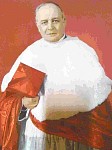
(46) 4. FORNI, Efrem
(1889-1976)
Birth. January 10, 1889, Milan, Italy. Second of the three sons of Enrico Giancarlo Forni and Angela Ambrosoli; the other brothers were Rutilio Pasquale and Luigi Iginio. He was baptized with the names Efrem Leone Pio.
Education. Studied at the University of Milan; at the Pontifical Gregorian University, Rome; and at the Pontifical Ecclesiastical Academy, Rome.
Priesthood. Ordained, July 6, 1913. Faculty member of archiepiscopal college of Cantu, and of college of d'Arona, Milan, 1913-1921. Secretary of the apostolic nunciature in Portugal, 1921-1926; auditor, 1926-1928. Honorary chamberlain of His Holiness, October 18, 1921; reappointed, August 12, 1922. Privy chamberlain of His Holiness, June 20, 1923. Auditor of the nunciature in France, 1928-1937; counselor, 1937. Domestic prelate of His Holiness, June 20, 1937.
Episcopate. Elected titular archbishop of Darni, November 26, 1937. Named nuncio in Ecuador, November 28, 1937. Consecrated, February 20, 1938, church of S. Carlo al Corso, Rome, by Cardinal Eugenio Pacelli, secretary of State, assisted by Alberto Levame, titular archbishop of Chersoneso di Zechia, nuncio in Honduras, El Salvador and Guatemala, and by Luigi Traglia, titular archbishop of Cesarea di Palestina, vice-gerent of Rome. His episcopal motto was Ardere et lucere perfectum. Papal legate to the National Eucharistic Congress, Quito, Ecuador, April 30, 1949. Nuncio in Belgium and internuncio in Luxemburg, November 9, 1953. Extraordinary papal legate to consign Golden Rose to the grand duchess of Luxemburg, July 8, 1956.
Cardinalate. Created cardinal priest in the consistory of March 19, 1962; received the red hat and the title of S. Croce in Gerusalemme, March 22, 1962. Attended the Second Vatican Council, 1962-1965. Participated in the conclave of 1963, which elected Pope Paul VI. Lost the right to participate in the conclave by being older than eighty years, January 1, 1971.
Death. February 26, 1976, after a short illness, in the Policlinico Agostino Gemelli, Roman hospital. Buried in a sarcophagus in the the church of S. Francesco in Gallarate, Milan, on the left side of the high altar; the late cardinal used to say that he received the gift of the priestly vocation in that church.
Webgraphy. Biography, in Italian, Wikipedia; biography, in English, Wikipedia; his arms, Araldica Vaticana.
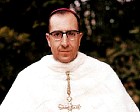
(47) 5. LANDÁZURI RICKETTS, O.F.M., Juan
(1913-1997)
Birth. December 19, 1913, Arequipa, Perú. Son of Gustavo Landázuri and María Rosa Ricketts. Baptized with the names Guillermo Eduardo; took the name Juan when he joined the Order of the Friars Minor.
Education. Initial studies at Colegio de los Sagrados Corazones, Arequipa; Colegio Arévalo, Arequipa (middle studies) where he had as professor of church history Father Juan Gualberto Guevara, future first Peruvian cardinal; National College, Arequipa; Faculty of Letters and Philosophy, University of San Agustín, Arequipa; in his third year, he decided to become a friar. Joined the Order of Friars Minor, missionary province of San Francisco Solano, April 28, 1933; Franciscan house of study in Ocopa (philosophy and theology); Pontifical Athenaeum Antonianum, Rome, 1946-1949 (doctorate in canon law thesis: "De aleniatione bonorum Religiosorum").
Priesthood. Ordained, April 6, 1939, Ocopa, by Francisco Irazola, O.F.M., titular bishop of Flaviade, apostolic vicar of Ucayalí. From 1939 to 1943, professor of canon law and pastoral theology in the Franciscan schools of his province, as well as popular preacher in different cities and towns of the region. Secretary to the General Delegation of his order, constituted because of the Second World War, 1943-1946. In 1943, he was named by Archbishop Juan Gualberto Guevara of Lima ecclesiastical assistant of the Union Nacional de Estudiantes Católicos: (UNEC); because of his post, he traveled to the United States of America, Spain, Switzerland, Italy, France, Belgium, England, Holland and Germany. Further studies, 1946-1949. Faculty member of the Franciscan Theological Seminary, Ocopa, and master of novices, 1949-1950. Minister and provincial of the St. Francisco Solano missionary province, 1950-1951. In the general chapter of the order, celebrated in Assisi in 1951, he was elected general definitor for Latin America; he went to reside in Rome; named member of the commission for the redaction of the actas of the general chapter; of the commission for the redaction of the general constitutions of the order; and of the commission for the redaction of "Acta Ordinis Fratrum Minorum"; occupied the post until 1952.
Episcopate. Elected titular archbishop of Roina and appointed coadjutor sedi datus of Lima, May 18, 1952. Consecrated, August 24, 1952, metropolitan cathedral, Lima, by Cardinal Juan Gualberto Guevara, archbishop of Lima, assisted by Leonardo Rodríguez Ballén, O.F.M., archbishop of Arequipa, and by León Uriarte Bengoa, O.F.M., titular bishop of Madaura. His episcopal motto was Ambulate in dilectione. Named vicar general of the archdiocese. Elected vicar capitular at the death of Cardinal Guevara, which occurred on November 27, 1954. Promoted to the metropolitan see of Lima, May 2, 1955.
Cardinalate. Created cardinal priest in the consistory of March 19, 1962; received the red hat and the title of S. Maria in Aracoeli, March 22, 1962. Attended the Second Vatican Council, 1962-1965. Participated in the conclave of 1963, which elected Pope Paul VI. Papal legate to the 6th National Eucharistic Congress, León, Spain, June 15, 1964; and to the Seventh National Eucharistic Congress, Huancayo, Perú, June 25, 1965. President of the Peruvian Episcopal Conference. Attended the First Ordinary Assembly of the Synod of Bishops, Vatican City, September 29 to October 29, 1967; the First Extraordinary Assembly of the Synod of Bishops, Vatican City, October 11 to 28, 1969; the Second Ordinary Assembly of the Synod of Bishops, Vatican City, September 30 to November 6, 1971; the Third Ordinary Assembly of the Synod of Bishops, Vatican City, September 27 to October 26, 1974; one of its three president delegates; the Fourth Ordinary Assembly of the Synod of Bishops, Vatican City, September 30 to October 29, 1977. Participated in the conclave of August 25 to 26,1978, which elected Pope John Paul I. Participated in the conclave of October 14 to 16, 1978, which elected Pope John Paul II. Attended the Third General Conference of Latin American Episcopate, Puebla, México, January 27 to February 13, 1979; the First Plenary Assembly of the Sacred College of Cardinals, Vatican City, November 5 to 9, 1979; the Fifth Ordinary Assembly of the Synod of Bishops, Vatican City, September 26 to October 25, 1980; the Sixth Ordinary Assembly of the Synod of Bishops, Vatican City, September 29 to October 28, 1983; the Second Extraordinary Assembly of the Synod of Bishops, Vatican City, November 24 to December 8, 1985. Resigned the pastoral government of the archdiocese of Lima, December 30, 1989. Following his retirement, he resided at Calle Luis Espejo 1064, Distrito de La Victoria, Lima. Today this residence houses the Archdiocesan Archive of Lima. Attended the Fourth General Conference of the Latin American Episcopate, Santo Domingo, Dominican Republic, October 12 to 28, 1992. Lost the right to participate in the conclave when turned eighty years of age, December 19, 1993. In 1996, the Episcopal Commission for Social Communications of the Peruvian Conference of Bishops renamed the "Premio Nacional de Periodismo Kukulí", established in 1978, as Premio Nacional de Periodismo y Comunicación Social Cardinal Juan Landázuri Ricketts. He was the last cardinal elector created by Pope John XXIII.
Death. January 16, 1997, from advanced stages of cancer, Lima. Buried in the chapel of Santo Toribio de Mogrovejo, second archbishop of Lima, in the metropolitan cathedral of Lima (1). The centennial of his birth was celebrated with a solemn mass presided by Cardinal Juan Luis Cipriani Thorne, archbishop of Lima, in the metropolitan cathedral of that see on December 19, 2013.
Bibliography. Chapeau, O.S.B., André and Charles N. Bransom. "Franciscan bishops." Franciscan Studies, XLVIII (1988), 300; Noriega Zegarra, Gustavo. El Cardenal amigo : testimonio de una experiencia inolvidable. Lima, Perú : Jaime Campodonico, 1999. (Cardinal Juan Landázuri Ricketts.
Webgraphy. Photographs and arms, Araldica Vaticana; Obispos del Perú inauguran monumento en memoria del Cardenal Juan Landázuri Ricketts, Conferencia Episcopal Peruana, 27 de enero 2020.
(1) This is the text of the inscription on vault, kindly provided by Mr. Eman Bonnci, from Malta:
EMMO. SEÑOR CARDENAL JUAN LANDAZURI RICKETTS O.F.M. XXX ARZOBISPO DE LIMA Y PRIMADO DEL PERU 19-12-1913 16-01-1997 PAZ Y BIEN
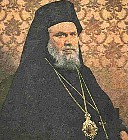
(48) 6. COUSSA, O.S.B.M.A., Gabriel Acacius
(1897-1962)
Birth. August 3, 1897, Aleppo, Syria. Son of Rizcallah Coussa and his wife Suzanne. He had two brothers, Georges and Nsri. His baptismal name was Gabriel Léon.
Education. Initial studies and part of his secondary ones at the Franciscan and Jesuit schools in Aleppo. Joined the Order of St. Basil of the Melkites of Aleppo at the monastery of Saint-Georges Deir-es-Chir in 1911; admitted to the novitiate in 1912, he took the name Acacius; sent to Rome to Collège Saint-Atanase, he made the simple profession on November 21, 1914 in the church of the Navicella; the First World War forced him to go to Switzerland because he was a Turkish citizen; he spent eighteen months in the Benedictine monastery of Einsiedeln, where he continued his theological studies; returned to Rome on November 9, 1916 thanks to the intervention of the Holy See before the Italian government; continued his studies at the Pontifical Urbanian Athenaeum "De Propoganda Fide," and resided at the Pontifical Greco-Roman College; he made the solemn profession on July 6, 1918 at the church of the Navicella, and received the minor orders; on July 11, 1920, he received the diaconate; obtained a doctorate in utroque iure, both canon and civil law, November 4, 1922.
Priesthood. Ordained, December 25, 1920, Rome, by Isaïe Papadopoulos, titular bishop of Grazianopoli, assessor of the S.C. of the Oriental Church. Director of the Melkite Scholasticate, Beyrut, Lebanon, 1921-1925. Assistant general of his order, December 19, 1925 to May 20, 1934. Superior of the monastery of Deir-es-Cheir, January 1929; at the end of the year, he left for Rome, where he arrived on December 31, 1929. Delegate of the Melkite hierarchy in the commission for the preparatory studies for the codification of the Oriental canon law, 1929-1935. Professor of canon law at the Pontifical Roman Athenaeum "S. Apollinare", 1932-1936. Assistant to the Pontifical Commission for the Preparation of the Oriental Canon Law, March 21, 1933; when the commission was charged with the redaction of the Code of Oriental Canon Law, he became its secretary, July 16, 1935. Professor of De personis of the Latin Code of Canon Law, at the Pontifical Institute "Utriusque Iuris," Rome, 1936-1953; dean of the faculty of canon law, 1946. Secretary of the Pontifical Commission for the Authentic Interpretation of the Code of Canon Law, March 3, 1946. Elected Assessor of the S.C. for the Oriental Church, January 15, 1953.
Episcopate. Elected titular archbishop of Gerapoli in Siria, February 26, 1961. Consecrated, Sunday April 16, 1961, Sistine chapel, the Vatican, by Pope John XXIII, assisted by Giovanni Mele, bishop of Lungro, for the Italo-Albanians of Continental Italy, by Giuseppe Perniciaro, titular bishop of Arbano, auxiliary and vicar general of the apostolic administrator of Piana degli Albanesi, by Archmandrite Théodore Minisci, higoumène of the Italo-Greek monastery of Grottaferrata, and by Archmandrite Ambroise Kassis, superior general of the Basilian Order of Aleppo. His episcopal motto was Misericordiam et veritatem diligit Dominus. Named pro-secretary of the S.C. for the Oriental Church on August 4, 1961.
Cardinalate. Created cardinal priest in the consistory of March 19, 1962; received the red hat and the title of S. Atanasio, March 22, 1962. Named secretary of the S.C. for Oriental Church on March 24, 1962.
Death. July 29, 1962, of peritonitis caused by appendicitis, in the hospital Salvator Mundi, Rome. The Byzantine divine liturgy, followed by a funeral service, was presided by Pope John XXIII in the patriarchal Vatican basilica on August 1, 1962. Temporarily buried in a crypt in the chapel of the S.C. for the Propagation of the Faith, next to Cardinal Pietro Fumasoni Biondi, Campo Verano cemetery, Rome. His remains were transferred to the church of S. Atanasio, Rome, his cardinalitial title, in May 1963.
Bibliography. Le Cardinal Gabriel Acace Coussa : Memorial. Beyrouth : L'Order basilien alépin, 1964; Del Re, Niccolò. "Gabriele Acacio Coussa" in La Sacra Congregazione per le Chiese Orientali. Nel cinquantesimo della fondazione (1917-1967). Grottaferrata, Roma : Tipografia Italo-Orientale "San Nilo", 1969, p. 93-95.
Webgraphy. His arms, Araldica Vaticana.
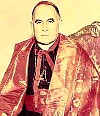
(49) 7. SILVA HENRÍQUEZ, S.D.B., Raúl
(1907-1999)
Birth. September 27, 1907, Talca, Chile. He was the sixteenth of the nineteen children of Ricardo Silva, a farmer and industrialist, of an old family of Portuguese origin that had established itself in Chile at the beginning of the 17th century. Five of the children died in infancy.
Education. Studied at the Catholic University of Chile, Santiago de Chile, where he earned a doctorate in law. Joined the Pious Society of St. Francis de Sales (Salesians of Don Bosco) on January 28, 1930, in Santiago de Chile; studied at the Salesian Philosophate, Santiago de Chile; and at the Pontifical Salesian Athenaeum, Turin, Italy, where he obtained doctorates in theology and canon law.
Priesthood. Ordained, July 3, 1938, Turin. Faculty member of the International Salesian Theological School, Santiago-Cisterna, 1938-1943. Director of the Salesian school "Manuel Arriaráan Barros", La Cisterna; and of the school "Patrocinio de San José", Santiago de Chile, 1943-1951. Founder and president of the Federation of Catholic Schools, 1945. Founder of the journal Rumbos, Santiago de Chile. Director of the International Salesian Theological School, Santiago-Cisterna, 1951-1957. Organized the First Congress of Consecrated Life, 1953. President of the Chilean delegation to the Congress of Consecrated Life, Buenos Aires, Argentina, 1956. Director of the professional school "Gratitud Nacional" and of the lyceum "San Juan Bosco", 1957-1959. Organizer and first director of the Catholic Chilean Institute of Migration; and national president of "Cáritas Chile"; vice-president of "Cáritas International".
Episcopate. Elected bishop of Valparaíso, October 24, 1959. Consecrated, November 29, 1959, cathedral of Valparaíso, by Opilio Rossi, titular archbishop of Ancira, nuncio to Chile, assisted by Emilio Tagle Covarrubias, titular archbishop of Nicopoli al Nesto, auxiliary of Santiago de Chile, and by Vladimiro Boric Crnosija, S.D.B., bishop of Punta Arenas. His episcopal motto was Caritas Christi urget nos. Promoted to the metropolitan see of Santiago de Chile, May 14, 1961.
Cardinalate. Created cardinal priest in the consistory of March 19, 1962; received the red hat and the title of S. Bernardo alle Terme, March 22, 1962. President of "Cáritas International", Rome, October 1962. Attended the Second Vatican Council, 1962-1965. Participated in the conclave of 1963, which elected Pope Paul VI. Papal legate to the International Mariological-Marian Congress, Higüey, Dominican Republic, February 2, 1965. Attended the First Ordinary Assembly of the Synod of Bishops, Vatican City, September 29 to October 29, 1967. Received the "Human Rights Prize" from the Latinamerican Jewish Congress, 1971. Established the Committee of Cooperation for Peace in Chile, 1973, followed by the Vicariate of Solidarity to defend and promote human rights in Chile during the politico-military crisis. Attended the Third Ordinary Assembly of the Synod of Bishops, Vatican City, September 27 to October 26, 1974. Participated in the conclave of August 25 to 26, 1978, which elected Pope John Paul I. Participated in the conclave of October 14 to 16,1978, which elected Pope John Paul II. Received the "Human Rights Prize" from the Organization of the United Nations, December 11, 1978. Attended the Third General Conference of the Latin American Episcopate, Puebla, México, January 27 to February 13, 1979. Received the "Foundation Bruno Kreisky" prize for his defense of human rights, Vienna, Austria, October 19, 1979. Attended the First Plenary Assembly of the Sacred College of Cardinals, Vatican City, November 5 to 9, 1979. Resigned the pastoral government of the archdiocese, May 3, 1983. Founder of the "Blas Cañas" University. Lost the right to participate in the conclave when turned eighty years of age, September 27, 1987. Attended the Fourth General Conference of the Latin American Episcopate, Santo Domingo, Dominican Republic, October 12 to 28, 1992.
Death. April 9, 1999, Salesian retirement house "Felipe Rinaldi", zone of La Florida, in the outskirts of Santiago, after failing to recover from a bout of pneumonia complicated by a kidney disorder. Exposed in the church of San Juan Bosco, Santiago; and buried in the crypt of the metropolitan cathedral of Santiago (1).
Bibliography. Aguilar, Mario I. "Cardinal Raúl Silva Henríquez, the Catholic Church, and the Pinochet Regime, 1973-1980 : Public Responses to a National Security State." Catholic Historical Review, LXXXIX, 4 (October 2003), 712-731; Albornoz, David : Toso, Mario. Il cardinale Raul Silva Henriquez. Dono di Dio alla Chiesa e al popolo cileno. Roma : Editrice LAS, 2007; Benítez Soto, Eduardo. Monseñor Raúl Silva Henríquez, 1961. Octavo Arzobispo de Santiago. Santiago, Chile: Editorial Salesiana, 1982 (Serie Arzobispos de Santiago); Pinochet de la Barra, Oscar. El Cardenal Silva Henríquez: luchador por la justicia. Santiago de Chile: Editorial Salesiana, 1987.
Webgraphy. Photographs and biography, in Spanish, archdiocese of Santiago de Chile; his arms and photographs, Araldica Vaticana; Cardenal Silva Henriquez, vithoco, published on Sep 6, 2007, YouTube; Homenaje al Cardenal Silva, Caetera Tolle, published on Sep 9, 2007, YouTube; "La Iglesia que yo Amo", Cardenal Raul Silva Henríquez, Parroquia Madre de Dios, published on Oct 26, 2007, YouTube; Homenaje al Cardenal Raúl Silva Henríquez, Juan Bautista, published on Jan 26, 2008, YouTube; Cardenal Raúl Silva Henriquez el gran chileno, fetoza, published on Apr 9, 2009, YouTube; Cardenal Raul Silva Henriquez, Stephanie López, published on Sep 4, 2012, YouTube; Funeral del Cardenal Raúl Silva Henriquez 1999, Sebastian Muñoz Olmos, published on Mar 20, 2013, YouTube; Documental Cardenal Raúl Sílva Henríquez, Sebastian Muñoz Olmos, published on Mar 21, 2013, YouTube; Raúl Silva Henríquez: "¿Será una utopía...?", Roberto Andrés Fuentealba Matus, published on Apr 9, 2014, YouTube; Cardenal Silva Henríquez, Universidad Católica Silva Henríquez, published on Apr 29, 2016, YouTube; Requiem de Chile: Cardenal Raúl Silva Henriquez, Sebastian Muñoz Olmos, published on Oct 4, 2016, YouTube; Requiem de Chile: Cardenal Raúl Silva Henriquez, Felipe Franco, published on Oct 4, 2016, YouTube; Radio Chilena 1978: Raúl Silva Henríquez en Pascua de Resurrección, Roberto Andrés Fuentealba Matus, published on Apr 19, 2017, YouTube; Conmemoran 20 años del fallecimiento del Cardenal Raúl Silva Henríquez, ACI Prensa, 11 de abril de 2019 8:47 am; Cardenal Silva Henríquez: Chile no debe olvidarte, Vatican News, 09 abril 2021, 15:00.
(1) This is the text of the inscription on his tomb, kindly provided by Mr. Eman Bonnici, from Malta:
CARDENAL RAUL SILVA HENRÍQUEZ EL AMOR DE CRISTO NOS URGE 27 DE SEPTIEMBRE DE 1907 9 DE ABRIL DE 1999
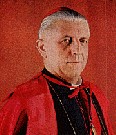
(50) 8. SUENENS, Leo-Jozef
(1904-1996)
Birth. July 16, 1904, at 6:30 a.m., in the clinic of the Sisters of Maternal Charity, Ixelles, archdiocese of Mechelen, Belgium. Son of Jean-Baptiste Suenens and Jeanne Jannsens. He was baptized in the church of Sainte-Croix, the parish of the maternity clinic, by a priest-uncle. He was an only child and lost his father when he was four. From 1911 to 1912, he lived with his mother in the parish house of the uncle who had baptized him at Klein-Villebroek. His name is also listed as Léon; and as Leon.
Education. Studied at "Institut Sainte-Marie", Schaerbeek; at the Pontifical Gregorian University, Rome, 1920-1927; 1927-1929, where he obtained doctorates in theology and philosophy; and a master's degree in canon law; while in Rome, he resided in the Pontifical Belgian College, Rome 1920-1927, and he was a college's librarian.
Priesthood. Ordained, September 4, 1927, Mechelen, by Cardinal Jozef-Ernest van Roey, archbishop of Mechelen. Further studies in Rome, 1927-1929. Professor at the "Institut Sainte-Marie", Schaerbeek, 1929. Professor of philosophy at the Minor Seminary of Mechelen, 1930-1940. Military chaplain with the 9th artillery regiment of the Belgian Army in southern France, May-August 1940. Vice-rector of the University of Louvain, August 1940; acting rector when Monsignor Honoré van Waeyembergh, the rector, was arrested by the Germans on June 5, 1944, just before the liberation of Belgium; the Germans included Monsignor Suenens' name on a list of thirty hostages who were to be executed; the Allies arrived just before the order would have been carried out. Privy chamberlain of His Holiness, October 2, 1941.
Episcopate. Elected titular bishop of Isinda and appointed auxiliary of Mechelen and vicar general, November 12, 1945. Consecrated, December 16, 1945, metropolitan cathedral of Mechelen, by Cardinal Jozef-Ernest van Roey, archbishop of Mechelen, assisted by Étienne Joseph Carton de Wiart, bishop of Tournai, and by Jan van Cauwenbergh, titular bishop of Sinao, auxiliary of Mechelen. His episcopal motto was In Spiritu Sancto. Promoted to the metropolitan see of Mechelen, November 24, 1961. The name of the see was changed to Mechelen-Brussels, December 8, 1961.
Cardinalate. Created cardinal priest in the consistory of March 19, 1962; received the red hat and the title of S. Pietro in Vincoli, March 22, 1962. Military vicar of Belgium, February 2, 1962. Attended the Second Vatican Council, 1962-1965; member of its board of presidency, 1963-1965. President of the Episcopal Conference of Belgium. Participated in the conclave of 1963, which elected Pope Paul VI. Attended the First Ordinary Assembly of the Synod of Bishops, Vatican City, September 29 to October 29, l967; the First Extraordinary Assembly of the Synod of Bishops, Vatican City, October 11 to 28, 1969; the Second Ordinary Assembly of the Synod of Bishops, Vatican City, September 30 to November 6, 1971. Extraordinary papal envoy to the millennium celebrations of Saint Ulderich's death, Augsburg, Germany, June 10, 1973. Attended the Third Ordinary Assembly of the Synod of Bishops, Vatican City, September 27 to October 26, 1974; the Fourth Ordinary Assembly of the Synod of Bishops, Vatican City, September 30 to October 29, 1977. Participated in the conclave of August 25 to 26,1978, which elected Pope John Paul I. Participated in the conclave of October 14 to 16,1978, which elected Pope John Paul II. Resigned the pastoral government of the archdiocese of Mechelen-Brussels, October 4, 1979. Participated in the First Plenary Assembly of the Sacred College of Cardinals, Vatican City, November 5 to 9, 1979. Lost the right to participate in the conclave when turned eighty years of age, July 16, 1984. Attended the Second Extraordinary Assembly of the Synod of Bishops, Vatican City, November 24 to December 8, 1985; special guest.
Death. May 6, 1996, of a thrombosis, in a clinic of Brussels. Buried in the metropolitan cathedral of Mechelen alongside his immediate predecessors Cardinals Jozef-Ernest van Roey and Pierre-Lambert Goossens (1).
Bibliography. Hamilton, Elizabeth. Suenens : a portrait. Garden City, N.Y. : Doubleday, 1975; Lesourd, Paul ; Ramiz, Jean-Marie. Leon Josef Cardinal Suenens. Notre Dame, IN : University of Notre Dame Press, 1964. (The men who make the council, 2); Suenens, Léon Joseph. Theology of the apostolate of the Legion of Mary : with letter of papal approbation. Cork : Mercier Press, 1953; Suenens, Leon-Joseph. Memories and hopes. Translated by Elena French. Dublin : Veritas, 1992. Note: First published in 1991 by Librairie Arthème Fayard, Paris, France.
Webgraphy. His arms and photographs, Araldica Vaticana; 25 anni fa la morte del Cardinale belga Suenens by Marco Mancini, ACI Stampa, Bruxelles, 06 maggio, 2021 / 3:00 PM; Udienza ai partecipanti al Simposio “Sulle orme del Cardinale Suenens-Lo Spirito Santo, Maria e la Chiesa”, promosso dall’Associazione “Fiat”, Sala Stampa della Santa Sede, 23.04.2022.
(1) This is the text of the inscription in his tomb kindly provided by Mr. Eman Bonnici from Malta:
LEO JOS. CARD. SUENENS I ARCHIEP. MECHL.- BRUX. 1961 - 1980 + 6 MAII 1996

(51) 9. BROWNE, O.P., Michael
(1887-1971)
Birth. May 6, 1887, Grangemokler, diocese of Waterford, Ireland. He was one of six children born to Maurice Brown and Kate Fitzgerald, four boys and two girls. One of the latter died in infancy and one of the boys in early adulthood, while his two other brothers became diocesan priests: Monsignor Pádraig de Brún, a renowned mathematician and classical scholar, who served as president of the University College of Galway and Monsignor Maurice, parish priest of Ballymore Eustace, County Kildare, and Hollywood, County Wicklow. He was baptized with the name Michael David.
Education. Joined the Order of Preachers (Dominicans) in Taillight, Dublin, in 1903; studied at Rockwell College; at the Convent of S. Clemente, Rome; and at the Theological Faculty of Fribourg, Switzerland.
Priesthood. Ordained, May 21, 1910, Rome. Faculty member and master of novices in the convent of Taillight, 1910-1919. Faculty member of the Pontifical International Institute "Angelicum," Rome, 1919-1932; 1941-1951. Prior of the convent of S. Clemente, Rome, 1925-1930. Rector magnifico of the Pontifical International Institute "Angelicum," Rome, 1932-1941. Master of the Sacred Palace, 1951-1955. Elected master general of the Order of Preachers, April 11, 1955.
Cardinalate. Created cardinal deacon in the consistory of March 19, 1962; received the red hat and the deaconry of S. Paolo alla Regola, March 22, 1962.
Episcopate. Elected titular archbishop of Idebesso, April 5, 1962. Consecrated, April 19, 1962, patriarchal Lateran basilica, Rome, by Pope John XXIII, assisted by Cardinal Giuseppe Pizzardo and by Cardinal Benedetto Aloisi Masella. In the same ceremony were consecrated Cardinals Joaquín Anselmo María Albareda, O.S.B., Antonio Bacci, Augustin Bea, S.J., Francesco Bracci, William Theodore Heard, Alberto di Jorio, André Jullien, P.S.S., Arcadio María Larraona, C.M.F., Francesco Morano, Alfredo Ottaviani and Francesco Roberti. His episcopal motto was Viae tuae veritas. Attended the Second Vatican Council, 1962-1965. Participated in the conclave of 1963, which elected Pope Paul VI. Attended the First Ordinary Assembly of the Synod of Bishops, Vatican City, September 29 to October 29, 1967. Lost the right to participate in the conclave by being older than eighty years, January 1, 1971.
Death. Wednesday March 31, 1971, in Santo Stefano Rotondo hospital in Rome's Caelian Hill, where he had been confined for several months with an incurable illness. Pope Paul VI had visited him there on Ash Wednesday, while returning from a procession, after the cardinal's condition had become serious. Upon his death, the cardinal was laid out in state at the Dominican priory of Santa Sabina, before being transferred to St. Peter’s Vatican Patriarchal Basilica, where a funeral Mass, presided by Pope Paul VI, was celebrated on April 4. Buried in the Dominican convent of Tallaght, Dublin (1).
Webgraphy. His photograph and arms, Araldica Vaticana.
(1) This is the text of the inscription on his vault, kindly provided by Mr. Eman Bonnici, from Malta:
MICHAEL DAVID BROWNE DOMINICAN · CARDINAL · ARCHBISHOP BORN 6TH MAY 1887 DIED 31ST MARCH 1971
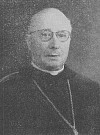
(52) 10. ALBAREDA, O.S.B., Joaquín Anselmo María
(1892-1966)
Birth. February 16, 1892, Barcelona, Spain. Son of Vicente Albareda and María Ramoneda. His baptismal name was Joaquín. He had an elder brother who was also a Benedictine monk at the Abbey of Montserrat, Dom Fulgenci Albareda i Ramoneda, who was martyred during the Spanish Civil War. Beatified along with 521 others in October 2013, his remains, along with those of 19 other martyred monks of the same Abbey, lie in the same crypt in which the Cardinal was laid to rest upon his death.
Education. Joined the Order of St. Benedict (Benedictines) at monastery of Montserrat, Montserrat, 1904; professed, November 4, 1908; took name of Anselmo María. Studied at the Athenaeum of St. Anselm, Rome; and at the Faculty of Paleography and Archives, Fribourg, Germany.
Priesthood. Ordained, July 7, 1915, Montserrat. Member of the community of Montserrat, 1915-1921. Further studies, 1921-1923. Archivist, monastery of Montserrat, 1923-1936. Prefect of the Vatican Library, June 19, 1936. He was responsible in the years of the Second World War for removing several libraries to safety in the Vatican, including those of the abbeys of Monte Cassino and Grottaferrata. Titular abbot of Santa Maria de Ripoll, May 5,1950; blessed by Cardinal Eugène Tisserant, bishop of Ostia and Porto e Santa Rufina, dean of the Sacred College of Cardinals, Montserrat, August 26, 1951.
Cardinalate. Created cardinal deacon in the consistory of March 19, 1962; received the red hat and the deaconry of S. Apollinare, March 22, 1962. After his promotion he continued living the simple life of a Benedictine monk.
Episcopate. Elected titular archbishop of Gissaria, April 5, 1962. Consecrated, April 19, 1962, patriarchal Lateran basilica, Rome, by Pope John XXIII, assisted by Cardinal Giuseppe Pizzardo and by Cardinal Benedetto Aloisi Masella. In the same ceremony were consecrated Cardinals Antonio Bacci, Augustin Bea, S.J., Francesco Bracci, Michael Browne, O.P., William Theodore Heard, Alberto di Jorio, André Jullien, P.S.S., Arcadio María Larraona, C.M.F., Francesco Morano, Alfredo Ottaviani and Francesco Roberti. His episcopal motto was Christi praeponere nihil amore. Attended the Second Vatican Council, 1962-1965. Participated in the conclave of 1963, which elected Pope Paul VI. He authored a number of scholarly works.
Death. July 19, 1966, at 12:18 a.m., of cancer, at Clínica Corachan in Barcelona, after seven unsuccessful surgeries, assisted by the Abbot of Subiaco, Dom Celestino Gusí, the Coadjutor Abbot of Montserrat, two fellow monks -including the latter monastery's archivist- and Brother Anselmo, who for thirty years assisted the cardinal during his presence in Rome. Buried in the Benedictine monastery of Montserrat (1).
Webgraphy. Biography by Josep Massot Muntaner, OSB, in Spanish, Diccionario Biográfico Español, DB~e; his arms, Araldica Vaticana.
(1) This is the text of the inscription on his vault, kindly provided by Mr. Eman Bonnici, from Malta:
JOAQUIM ANSELM M. ALBAREDA I RAMONEDA MONJO DE MONTSERRAT ARQUBISBE I CARDENAL DE LA SANTA ESGLESIA ROMANA PREFECTE DE LA BIBLIOTECA VATICANA SOTA PIUS XI PIUS XII I JOAN XXIII 10 DE FEBRER DE 1892 - 20 DE JULIOL DE 1966 FEU-NE MEMORIA DAVANT EL SENYOR

DELLEPIANE, Giovanni Battista
(1889-1961)
Birth. February 21, 1889, Montelungo di Bavari, Genoa, Italy. His family had old roots in the locality.
Education. Initial studies at the Elementary School of Montelungo; then, studied at the Minor Seminary of Genoa; and finally, at the Archiepiscopal Seminary, Genoa. One of his classmates was Giacomo Lercaro, future archbishop of Bologna and cardinal.
Priesthood. Ordained on July 25, 1914, for the archdiocese of Genoa. Curate of the parish of Nostra Signora delle Grazie in Sampierdarena for a few months, until he was called to the front as military chaplain. At the end of the War, he returned to Genoa, where he was assigned as vice-parish priest of Voltaggio. Archbishop Federico Vallega of Izmir, Turkey, asked him to be his personal secretary. From 1921, he served as vicar general and chancellor of the Archdiocese of Izmir. He distinguished himself for his humanitarian activities during the final days of the Greco-Turkish War in the autumn of 1922, when a fire destroyed the archiepiscopal palace, the Curia and part of the cathedral. When Archbishop Vallega resigned from the pastoral government of the see in 1929, Monsignor Dellepiane remained in Izmir, acting as apostolic administrator.
Episcopate. Elected titular archbishop of Stauropoli, July 18, 1929. Consecated, November 30, 1929, by Cardinal Willem Marinus van Rossum C.SS.R., prefect of the Congregation for the Propagation of the Faith, assisted by Giovanni Battista Federico Vallega, titular archbishop of Nicopoli in Epiro, and by Angelo Cambiaso, bishop of Albenga. Appointed apostolic delegate in Belgian Congo, January 18, 1930; he ordained the first natives to the priesthood. On January 12, 1949, he was named apostolic internuncio to Austria. On December 21, 1951, he was named nuncio to Austria.
Cardinalate. In August 1961, a telephone call from Rome was received at the apostolic nunciature in Austria, informing that the nuncio was to be elevated to the Sacred College of Cardinals by Pope John XXIII. Already on his deathbed, he passed away a few days later.
Death. Sunday, August 13, 1961, Vienna, of cancer. Three requiem Masses were held for him. The first at the cathedral of Saint Stephen in Vienna, the second at the cathedral of Saint Lawrence in Genoa, followed by another at the parish church of San Giorgio di Bavari, where he was interred in its chancel.
Webgraphy Giovanni Dellepiane. Dalle campagne di Bavari ai vertici della Chiesa, Il Drago Buono, Il Giornale di Bavari e dei Bavaresi, November 27, 2011; biography, in English, Wikipedia.
©1998-2023 Salvador Miranda.